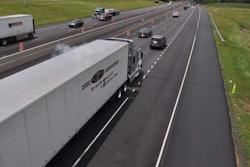
 Kristen Monaco, an economist at the Department of Labor’s Bureau of Labor Statistics, said Wednesday that there’s little evidence that there’s a driver shortage within the trucking industry — including the long-haul segment. Instead, she said, the problem lies with the industry’s driver churn rate, with industry recruiting practices exacerbating the issue. (Photo courtesy of FTR.)
Kristen Monaco, an economist at the Department of Labor’s Bureau of Labor Statistics, said Wednesday that there’s little evidence that there’s a driver shortage within the trucking industry — including the long-haul segment. Instead, she said, the problem lies with the industry’s driver churn rate, with industry recruiting practices exacerbating the issue. (Photo courtesy of FTR.)Continuing to buck a key talking point within the industry, promoted particularly heavily by the American Trucking Associations, researcher Kristen Monaco on Wednesday reiterated a point she made in a research piece published this March: There is no driver shortage in the trucking industry.
Monaco, an associate commissioner at the Department of Labor’s Bureau of Labor Statistics, spoke Wednesday at the FTR Transportation Conference in Indianapolis, Indiana.
Driver turnover is indeed a major issue, she says. And there’s plenty of anecdotal evidence of carriers struggling to fill seats. However, those issues do not mean there’s an actual shortage of drivers, Monaco argues. What’s largely perceived as a labor shortage is in fact a retention issue, with heavy recruiting efforts by fleets contributing to the persistently high turnover rates, she says.
“If you talk about a labor market and characterize that there’s a shortage for several decades, that means the market is somehow broken,” she said. “The quantity of labor demanded is constantly greater than quantity of labor supplied.”
As her report from March detailed, however, there’s no evidence that the driver market is broken, Monaco said. Instead, it’s “a combination of wage, hours and working conditions that describes what’s going on.”
When fleets raise pay, they draw more workers into the driver pool, she said. “Which is exactly what we would expect to see if the market is working the way it should.”
From a long-term perspective, raising wages helps calm turnover and grow the driver pool. However, Monaco contends, fleets often find it easier and cheaper to simply continue the churn cycle and hire new drivers instead of raising wages. And “with the sheer number of carriers who are doing it, accelerates the churn,” she says. “I think moderate wage increases are better in the aggregate, but that involves a lot of cooperation, because it’s still going to be faster and easier for individual carriers to go and poach other drivers.”
Monaco also diverges from the general take within the industry that the average age of the driver population is cause for concern for the driver labor market. The American Trucking Associations, for instance, points to the age of the driver pool as potentially exacerbating the need for new drivers in the coming years.
Monaco, however, says driving jobs have always been filled by older males. “Another area I might disagree… is this perception that truck driving was ever an occupation for a young person. Historically, it never was. I did surveys of truck drivers in the Midwest, in 1997/1998. I just took a road trip through the Midwest where we stopped at some truck stops, and the demographics [then] looked remarkably similar” to today’s, she said.
Monaco co-authored a report, released in March, with Stephen V. Burks, an economics professor at the University of Minnesota Morris, with their key conclusion being that there’s no evidence of a driver shortage in trucking from an economics perspective.
After that report was released, ATA Chief Economist Bob Costello refuted their findings, saying that the authors “demonstrate some basic misunderstandings about the trucking industry.”
In late July, ATA and Costello released a report arguing that the driver shortage persists, and that they expect it to worsen in the coming decade.














